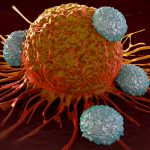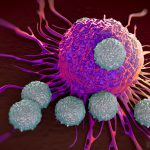It’s akin to reporting a break-in, Dr. Khader said. If a person calls 911 because of a robbery, but doesn’t give a specific address, the police could come to the neighborhood but don’t know for certain which home was invaded. In the body, a molecule called CXCR5 can tell the immune cells which lung cells contain TB bacteria so that they can surround them in a structure called a granuloma to thwart further spread of the infection.
For the study, which was funded by the National Institutes of Health, the researchers studied human TB-infected cells as well animal models of the disease. They found that granulomas that contain ectopic lymphoid structures, which resemble lymph nodes, are associated with effective suppression of TB, and that granulomas that don’t contain them are associated with active TB. They also learned that immune cells called T cells that had a surface marker molecule called CXCR5 were associated with the presence of ectopic lymphoid structures.
“The protective power of CXCR5 points us in a novel direction for future management of TB,” Dr. Khader said. “These findings have powerful implications for the development of vaccines to prevent infection.”
More than 2 billion people or one-third of the world’s population are infected with mycobacterium tuberculosis, the bacterium that causes TB, Dr. Khader said. The infection is challenging to treat partly because the bacillus is able to enter cells and linger for years without causing symptoms, known as latent TB. Then, typically when the immune system becomes impaired due to other reasons such as age or HIV, the infection becomes active and causes the cough, night sweats, fever and weight loss that characterize the disease.
Study: Targeting Tuberculosis
By: Anita Srikameswaran and Tim Betler
The presence of a certain molecule allows the immune system to effectively police tuberculosis (TB) of the lungs and prevent it from turning into an active and deadly infection, according to a new multicenter study led by Shabaana A. Khader, Ph.D., an assistant professor of pediatrics at the University of Pittsburgh School of Medicine and Children’s Hospital of Pittsburgh of UPMC. The study was published today in the online version of the Journal of Clinical Investigation.
-
Up NextDetermining Your Course: Goal Setting for 2013
-
Police Officer Motorcycle Club Brings Toys to Kids at UPMC Mercy Burn Center
-
Unique Fitness Program at Magee Offers More Than Just Exercise
-
Need More Sleep? UPMC Experts Offer Tips To Help
-
Pregnant Women Encouraged to Get Flu Shot
-
Free Webinars Help Hospitals Improve Community Health








